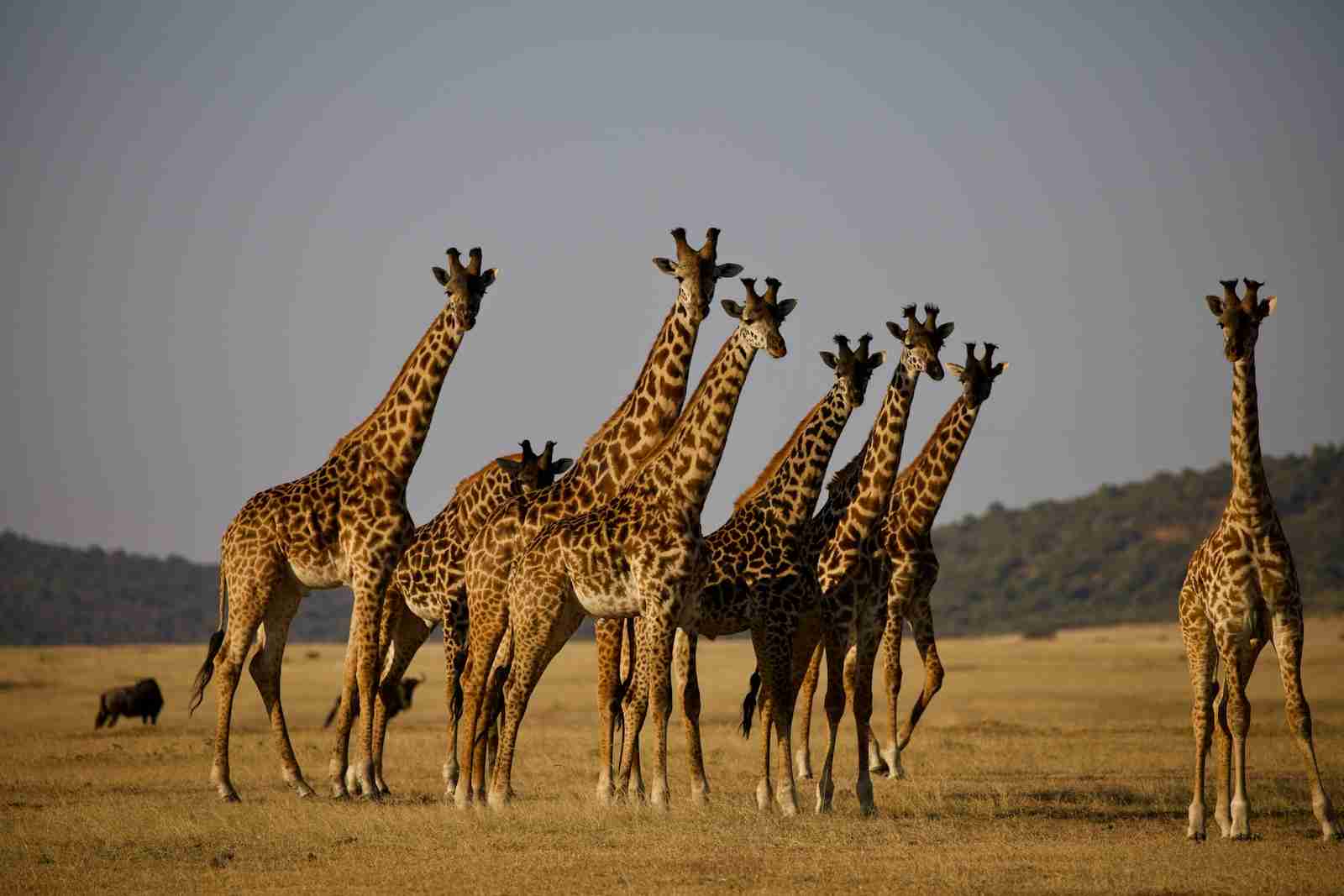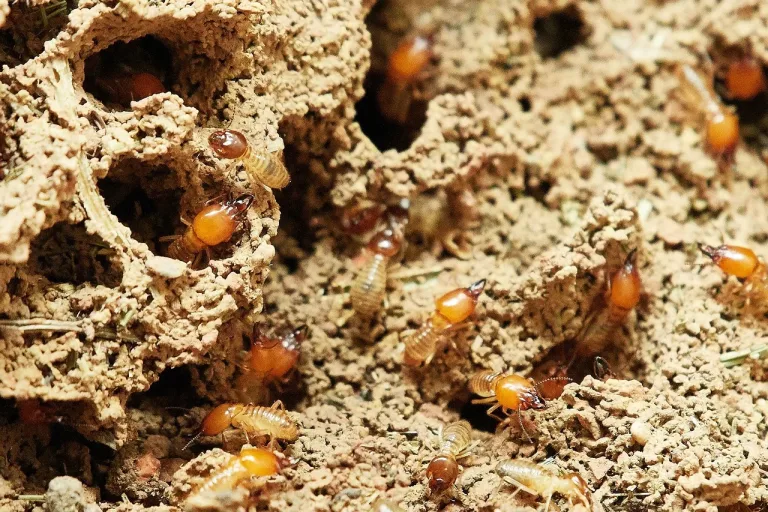23 Fun Facts About Giraffe | Sky-High Elegance in Stripes
1. NASA has studied Giraffes’ blood pressure regulation for space suit technology.
NASA looked into how giraffes manage their blood pressure because of the way they handle gravity, especially when they bend down. This research in 1997 helped NASA improve space suits for astronauts.
They found giraffes’ leg veins and tight skin acting like compression socks, inspiring designs to help astronauts deal with the effects of weightlessness in space.
2. Giraffes’ tongues are dark purple, up to 20 inches long, and prehensile.
Giraffes have a unique dark purple tongue, about 20 inches long, that helps them avoid sunburn while eating leaves in the bright sun. Thanks to its tough, finger-like papillae, this prehensile tongue can grab and pull leaves, even from thorny branches.
This special feature not only protects their mouth but also allows them to feed efficiently on their favorite acacia trees.
3. A Giraffe’s heart can weigh up to 25 pounds and is two feet long.
Another interesting giraffe fact is that it possesses the largest heart of any land mammal, weighing about 25 pounds and measuring two feet long. Their massive heart, pumping 60 liters of blood every minute, and large lungs holding 12 gallons of air, support their unique physique.
Unlike other mammals, a giraffe’s heart has a thick muscle to power blood flow against gravity, ensuring their tall bodies are well-supplied.
4. Giraffes stand while sleeping, requiring only 30 minutes of rest daily.
Giraffes, often preyed upon, sleep standing up to stay alert, managing only about 30 minutes daily through brief 5-minute naps. Their unique sleeping habits, including keeping one eye open and ears alert, help them stay aware of predators.
In captivity, however, they can relax more, enjoying over 4 hours of sleep, occasionally resting their necks on their hindquarters for comfort.
5. How does a Giraffe drink water?
To drink, giraffes must spread their legs and kneel, as their necks can’t reach the ground. They use a special system to prevent blood from rushing to their brain and sip water with puckered lips, holding it in their esophagus until they stand up again.
Though capable of drinking 10 gallons daily, giraffes rarely do, mainly obtaining moisture from plants and drinking sporadically.
6. Giraffes have been depicted in art dating back to the early rock paintings of Africa.
Giraffes have fascinated humans since ancient times, appearing in African rock paintings like the Dabous Giraffes in Niger, dating back 9,000 years. Discovered in 1987, these life-size engravings showcase giraffes’ significance in Neolithic art.
Additionally, ancient Egyptians depicted giraffes in wall paintings, and their tails were valued tributes, highlighting their long-standing presence in human culture and art.
7. Giraffes walk moving both legs on one side of their body at the same time.
Giraffes have a distinctive gait called pacing, where they simultaneously move both legs on one side of their body and then switch to the other side.
This unique way of walking enables them to glide smoothly and sprint, reaching speeds up to 35 miles per hour for short bursts, differentiating their movement from horses and most other quadrupeds.
8. Giraffe spots are unique to each individual, much like human fingerprints.
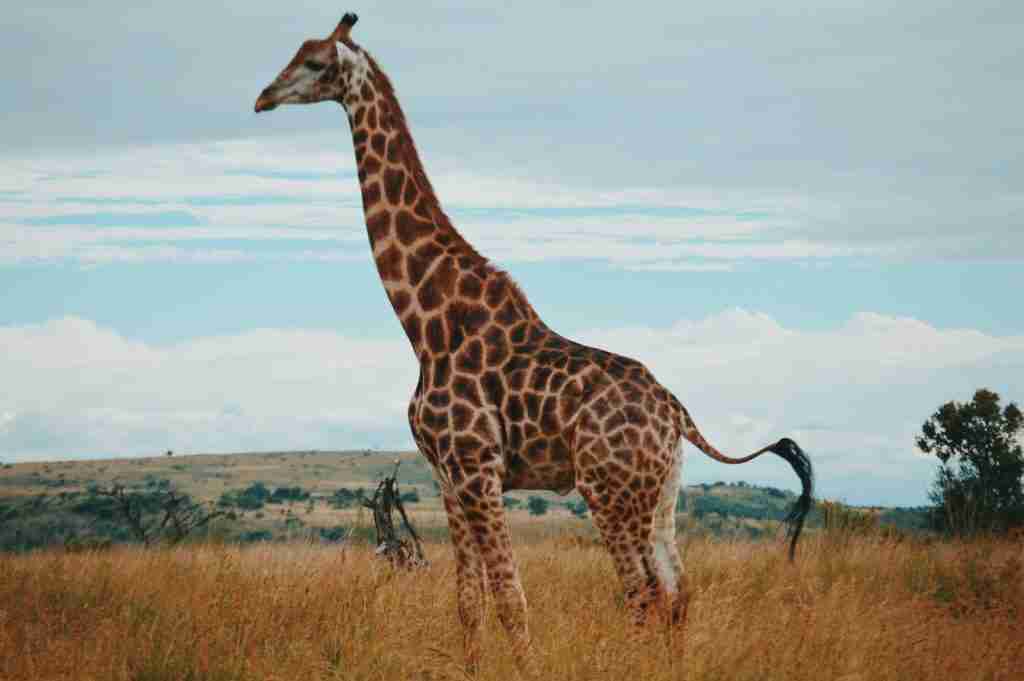
Another lesser-known giraffe fun fact is that their spots are as unique as human fingerprints, with no two giraffes sharing the same pattern. These spots serve as camouflage and help regulate body temperature through a specialized system of blood vessels.
Recently, software has been developed to identify individual giraffes by their unique spot patterns, aiding in research and conservation efforts.
9. Giraffes have a four-chambered stomach and eat up to 75 pounds of food a day.
Giraffes, with their herbivorous diet, have a unique digestive system featuring a single stomach divided into four compartments, making them ruminants like cows and sheep.
They can consume up to 165 pounds of food daily, using their long tongues to grab leaves and chewing cud to break down cellulose for energy. This efficient system supports their large size and nutritional needs.
10. Female Giraffes give birth standing up.
Female giraffes give birth standing up, causing the newborn calf to fall about 2 meters to the ground. Remarkably, the calf can stand and walk within an hour of birth, equipped with flat ossicones to prevent injury to the mother.
These calves stay close to their mothers for 1.5 years, quickly adapting to life on their feet from the moment they’re born.
11. How do Giraffes help the environment?
Giraffes significantly contribute to ecosystem balance by consuming foliage beyond the reach of other animals, stimulating plant growth, and creating habitats for smaller species.
As a keystone species in African ecosystems, their survival is pivotal; protecting giraffes also means safeguarding the myriad of species dependent on the same environment, thus ensuring the overall health and diversity of their habitats.
12. Male Giraffes engage in necking battles to establish dominance.
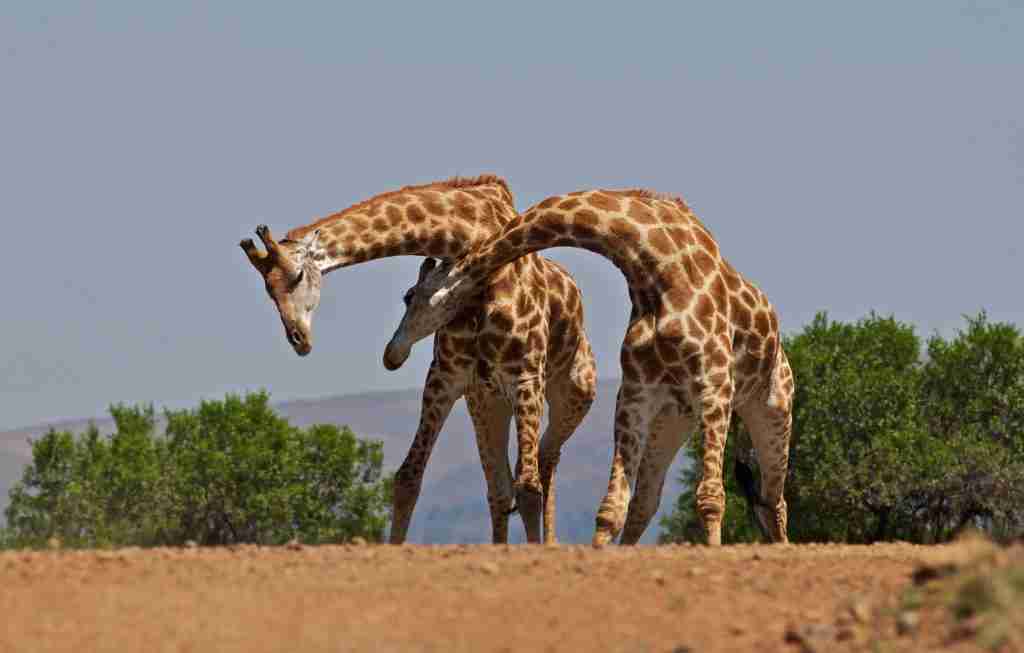
Male giraffes engage in a behavior known as necking, where they battle for dominance and mating rights by swinging their necks and striking each other with their ossicones.
These contests, while rarely causing severe injury, demonstrate their strength and status. In intense fights, they deliver powerful blows, using their ossicones as weapons to assert dominance over rivals.
13. Giraffes’ necks have special valves to regulate brain blood flow when they bend down.
Giraffes have uniquely adapted jugular veins equipped with one-way valves to control blood flow to their brains when bending down to drink. This adaptation prevents excess blood from flooding the brain, safeguarding against sudden changes in blood pressure.
The elastic walls of these veins expand significantly, ensuring the giraffe’s brain remains protected while lowering its head, a critical feature for their survival.
14. Giraffes have been extinct in at least seven countries in Africa.
Once widespread across 28 African countries, giraffes are now extinct in at least seven, including Burkina Faso, Eritrea, Guinea, Mali, Mauritania, Nigeria, and Senegal.
The decline in wild giraffe populations, particularly in northern Africa, is attributed to human activities such as habitat loss and illegal poaching, compounded by their low reproduction rate, placing them at risk of further extinction.
15. The first Giraffe in Europe was brought by Julius Caesar in 46 BCE.
In 46 BCE, Julius Caesar brought the first giraffe from Alexandria to Europe, introducing this extraordinary creature to Rome.
It featured in Caesar’s triumphal procession and was later displayed in the Colosseum’s circus games, marking over a millennium before another giraffe would be seen on the continent.
16. What are the Giraffe horns called?
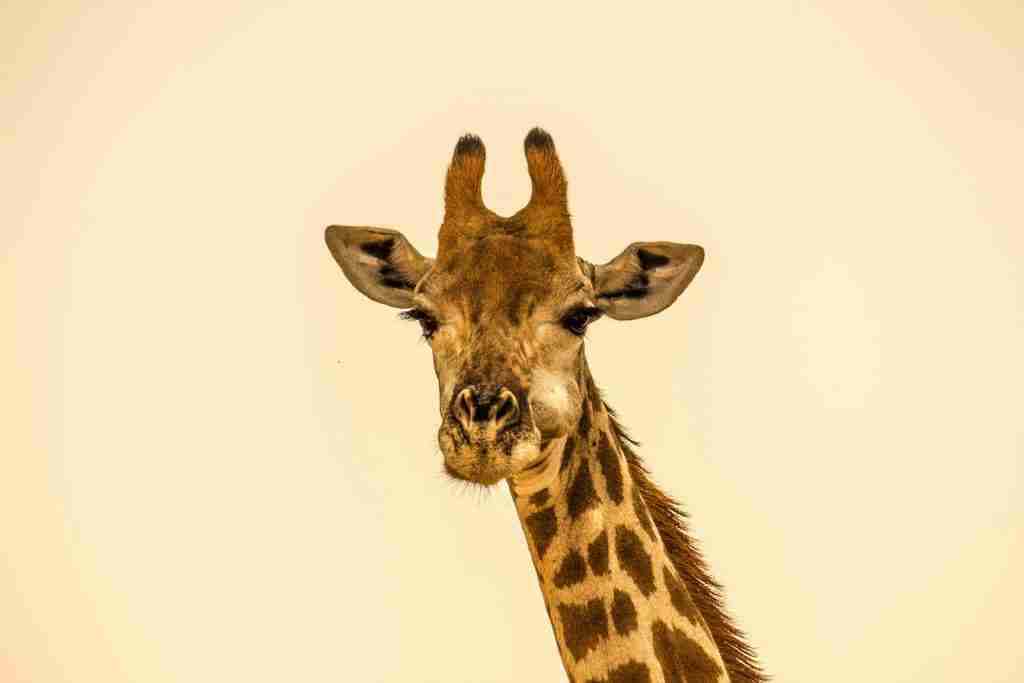
Giraffe ‘horns’ are called ossicones, present in both males and females, formed from ossified cartilage and skin-covered. Males use these ossicones as weapons in combat, enhancing the force of their blows by concentrating impact onto a smaller area.
These columnar or conical bone structures on their heads play a crucial role in their interactions and defense mechanisms.
17. Male giraffes will test a female’s fertility by tasting her urine.
Male giraffes engage in a unique behavior known as the “flehmen response” by tasting a female’s urine to detect pheromones indicating her fertility.
This process involves the male curling his lips and sampling the urine to determine if the female is ready to mate, as female giraffes lack visible mating signals. This behavior has been observed by biologists in Namibia.
18. Giraffa camelopardalis’ name comes from Greeks likening it to a camel-leopard hybrid.
The giraffe’s scientific name, Giraffa camelopardalis, is derived from the ancient Greeks’ observation, mistaking its appearance for a camel draped in a leopard’s coat.
This naming occurred when Julius Caesar introduced giraffes to Europe, fascinating the Romans with their unique look. A giraffe’s body, resembling a camel’s shape and spotted like a leopard, typically features around 200 distinct spots.
19. The Giraffe’s neck has the same number of vertebrae as a human neck.
Despite their necks reaching up to eight feet in length and weighing as much as 600 pounds, giraffes have only seven neck vertebrae, mirroring the human count.
However, each giraffe vertebra is significantly elongated, measuring up to 10 inches each. This unique adaptation allows for their remarkable neck length while maintaining a vertebrae count identical to humans.
20. Oxpeckers and Giraffes share a symbiotic bond.
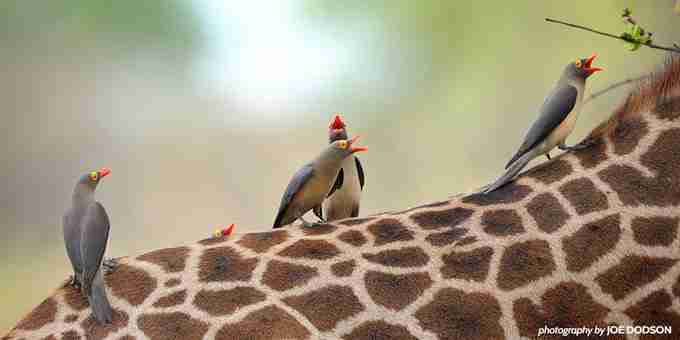
Giraffes and oxpeckers share a symbiotic relationship where oxpeckers feed on ticks and parasites on giraffes, benefiting both by removing harmful pests.
While oxpeckers rely on giraffes for food, making their relationship lean towards mutualism, giraffes are not as dependent, suggesting a slight tilt towards parasitism. This partnership highlights the complex interactions within savanna ecosystems.
21. Giraffes have a unique pattern of skin that is useful for thermoregulation.
Research led by G. Ian Taylor from The University of Melbourne reveals giraffes’ dark skin patches act as “thermal windows” for effective body thermoregulation.
This unique skin structure, along with a specialized blood vessel arrangement, enables rapid heat diversion. Giraffes also adjust their body orientation and seek shade to minimize heat gain, showcasing their evolved adaptations for temperature control.
22. There are four distinct species of Giraffes in the world.
Comprehensive DNA analysis by the Giraffe Conservation Foundation and partners has identified four distinct giraffe species: Masai, Northern, Reticulated, and Southern giraffes, along with several subspecies.
These include the Angolan and South African giraffes under Southern; Nubian, Kordofan, and West African under Northern; and the Luangwa and Masai as subspecies of the Masai giraffe, with Rothschild’s giraffe classified as Nubian.
23. A Giraffe’s age can be gauged by its spots.
Research led by Madelaine Castles from the University of Queensland, Australia, reveals that the color of a giraffe’s spots can indicate its age.
Specifically, a study on Thornicroft’s giraffes in Zambia found that males’ spots darken with age, ranging from pale brown to black. This discovery suggests that spot color, intensifying over time, serves as a secondary sexual trait in giraffes.
FAQs
Yes, giraffes are generally friendly and gentle, rarely attacking humans. Those born in captivity, like in zoos, often grow accustomed to people and show trust unless frightened. Their massive size belies their calm demeanor.
Giraffes, including young ones, sometimes engage in necking not just for dominance or attracting females, but also for fun, especially after a hearty meal. This playful behavior involves swinging their long necks and butting heads, typically without causing harm to each other.
Giraffes sleep both standing up and lying down, with new findings revealing they lie down more often than once believed. In the wild, they take short naps standing to stay alert for predators, but in captivity, they tend to sleep longer hours lying down, folding their legs underneath and often keeping their necks upright, even while resting.
Being the tallest of mammals, the mating experience for giraffes is a bit tricky, requiring the male to carefully rear up on his hind legs and mount the female from behind. This process, often brief and repeated several times, demands precise coordination, especially since the female may continue moving.
A giraffe’s neck can extend over 7 feet, making up nearly half its height, and weighs up to 600 pounds. Unlike humans’ shorter vertebrae, a giraffe’s seven-neck vertebrae can each exceed 10 inches in length.

